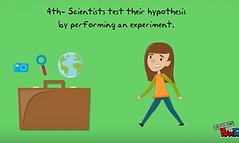
Science Instruction Showcase
These artifacts show some of the innovative lessons and activities that I have developed and implemented to teach science.
Gravity and Our Solar System New Media Website Lesson
As a science teacher, it is clear how new media or in more general terms, technology, directly relates to my instruction of science concepts. Not only does the study of technology fall under the science umbrella, but my students are growing up in a constantly evolving technological world. Much of their life consists and depends on the use of new media. Therefore, I designed a website that ties in different forms of new media for a lesson about gravity. This website has two main functions. One function is to walk my 5th grade students through a lesson on gravity that has new media integrated throughout it, from interactive websites to collaboration websites. The other function is to guide colleagues through my new media-integrated gravity lessons and give a rationale as to why it is useful.
The Truth about the Process of Science PowToon
Our Stolen Future by Theo Colborn is a book that explains the scientific research of how manmade chemicals are causing hormone-disruptions in both wildlife and humans. This book clearly illustrates how science is not a step-by-step process like the scientific process states, which we have taught our youth for decades. The newly-adopted Next Generation Science Standards have eliminated the scientific process and replaced it with the eight science and engineering practices. These practices contain all of the elements of the scientific process and more. Most importantly and what Our Stolen Future so clearly illustrates is how these science and engineering practices can be performed as many times as necessary and in any order during a scientific investigation. I developed a PowToon to show this shift in scientific thinking.
Properties of Rocks and Minerals Unit Plan
Developing and implementing a concrete, complete, and cohesive unit plan to teach third graders about the properties of rocks and minerals requires a lot of work and thought. Multiple steps in the unit planning process are often skipped. In the following document, I started by identifying learning goals based off of science Grade Level Content Expectations (GLCE). I then developed and Experience, Pattern, and Explanation (EPE) table that identified what experiences I would give my students and what explanations I would hope they would gain from them. Afterwards, I designed, administered, and analyzed a pre-assessment to inform and guide my instruction. Based on those results, I developed an Inquiry Application Instruction Model (I-AIM) and individualized lesson plans, which spelled out my plans. I also designed, administered, and analyzed a post-assessment.


